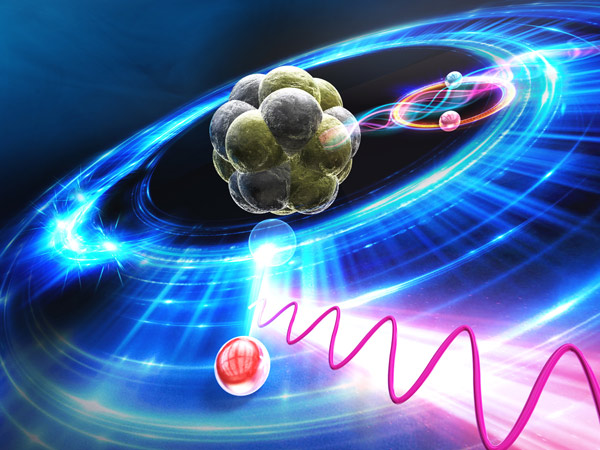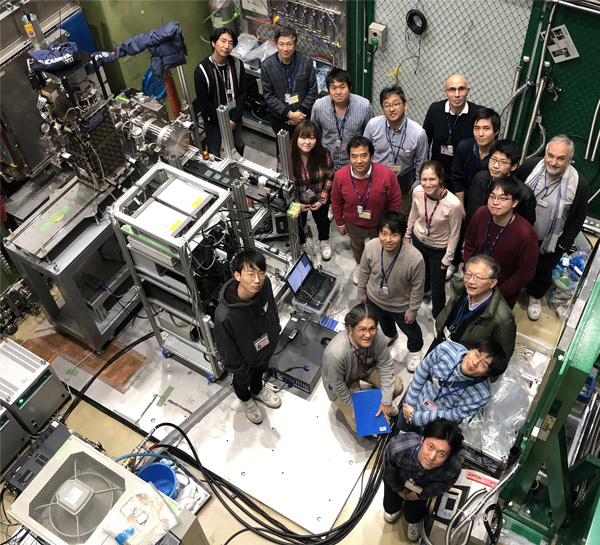Oct. 2, 2023 Research Highlight Physics / Astronomy
Quantum electrodynamics passes high-field test
A quantum theory of electrodynamics is shown to be accurate even at the very high electric fields of exotic atoms
By creating special atoms, RIKEN physicists have tested what happens to quantum electrodynamics (QED)—a quantum theory describing the interaction of charged particles with electromagnetic fields—when the electric field is ramped up1. The demonstration opens the possibility of using the exotic atoms to perform further experiments at high fields.
QED is a highly successful theory that combines two pillars of modern physics—special relativity and quantum physics. The quantum equivalent of classical electromagnetics formulated by James Maxwell, QED was developed by some of the greatest minds of 20th century physics, including Richard Feynman, Julian Swinger and Shinichiro Tominaga.
So far it has passed every test thrown at it over the last 70 years with flying colors. But most experiments have been performed at low electric fields. Physicists are keen to discover if QED’s untarnished record extends into high fields, especially since theoretical calculations become much harder to perform in this region.
“QED has not been well verified at all in the high-field regime of x-rays,” notes Toshiyuki Azuma of the RIKEN Atomic, Molecular and Optical Physics Laboratory.
But since these high fields go beyond those that exist in normal atoms, such measurements have been challenging to perform.

Figure 1: A conceptual image depicting a muonic neon atom and quantum electrodynamic (QED) effects. © 2023 RIKEN Atomic, Molecular and Optical Physics Laboratory
Now, to test QED in the high-field regime, Azuma and his co-workers have performed high-precision measurements on special neon atoms, which they made using the facilities at the Japan Proton Accelerator Research Complex (J-PARC).
To create the atoms, the team stripped off all their electrons by adding a muon—a subatomic particle that has the same negative charge as an electron, but is about 207 times heavier. This larger mass means that the muon resides much closer to the atom’s nucleus and thus experiences a much greater electric field from the protons in the nucleus.
Measurements of x-rays emitted by these atoms agreed well with values predicted by QED. While QED lives to see another test, the real value of the experiments was their demonstration of the usefulness of muonic atoms for probing high-field QED.
Both the measurements and the subsequent analysis were demanding. “Two things enabled us to succeed in performing this measurement,” Azuma says. “One is we had highly sensitive detectors and the other is we had access to intense, low-energy muon beams that are only available in Japan right now.” He notes that the detectors were originally developed for an x-ray satellite for astronomical observations. “It was also quite tough to analyze the results,” Azuma adds. “We needed more than two years.”

Toshiyuki Azuma (green jacket, third from the front on the right) and his team in the laboratory where they tested quantum electrodynamics (QED) in the high-field regime by using muonic atoms of neon. © 2023 RIKEN
Related content
Rate this article
Reference
- 1. Okumura, T., Azuma, T., Bennett, D. A., Chiu, I., Doriese, W. B., Durkin, M. S., Fowler, J. W., Gard, J. D., Hashimoto, T., Hayakawa, R. et al. Proof-of-principle experiment for testing strong-field quantum electrodynamics with exotic atoms: high precision X-ray spectroscopy of muonic neon. Physical Review Letters 130, 173001 (2023). doi: 10.1103/PhysRevLett.130.173001
